Conopophaga
Conopophaga is a genus of birds in the gnateater family. Its members are found in forest and woodland in South America.
| Conopophaga | |
|---|---|
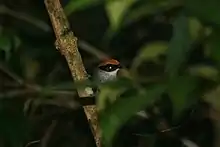 | |
| Black-cheeked gnateater (Conopophaga melanops) | |
| Scientific classification | |
| Domain: | Eukaryota |
| Kingdom: | Animalia |
| Phylum: | Chordata |
| Clade: | Dinosauria |
| Class: | Aves |
| Order: | Passeriformes |
| Family: | Conopophagidae |
| Genus: | Conopophaga Vieillot, 1816 |
| Type species | |
| Turdus auritus Gmelin, JF, 1789 | |
| Species | |
|
See text | |
Taxonomy and species list
The genus Conopophaga was introduced in 1816 by the French ornithologist Louis Jean Pierre Vieillot.[1] The name combines the Ancient Greek kōnōps meaning "gnat" with -phagos meaning "-eating".[2] The type species was subsequently designated as the chestnut-belted gnateater by George Robert Gray in 1840.[3][4] The genus now contains ten species, all with "gnateater" in their common names.[5]
| Image | Scientific name | Common Name | Distribution |
|---|---|---|---|
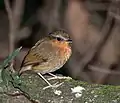 | Rufous gnateater | Conopophaga lineata | eastern Brazil from Rio Grande do Sul north to central Brazil |
%252C_Novo_Air%C3%A3o%252C_Amazonas%252C_Brazil.jpg.webp) | Chestnut-belted gnateater | Conopophaga aurita | Amazonia and the Guianas |
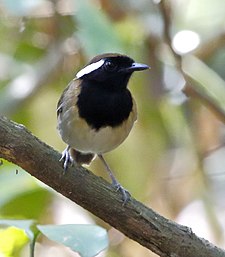 | Black-breasted gnateater | Conopophaga snethlageae | Amazonian Brazil. |
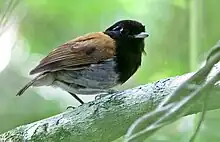 | Hooded gnateater | Conopophaga roberti | northern Brazil |
| Ash-throated gnateater | Conopophaga peruviana | western Amazon Basin of Brazil, Peru and Ecuador | |
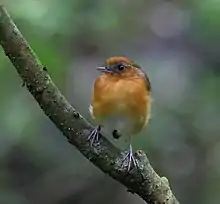 | Ceará gnateater | Conopophaga cearae | Brazilian states: Ceará, Pernambuco, Paraíba, Rio Grande Do Norte, and Alagoas |
| Slaty gnateater | Conopophaga ardesiaca | Yungas of Bolivia and eastern Peru | |
 | Chestnut-crowned gnateater | Conopophaga castaneiceps | Colombia, Ecuador, and Peru |
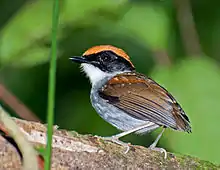 | Black-cheeked gnateater | Conopophaga melanops | Brazil |
%253B_Caraj%C3%A1s_National_Forest%252C_Par%C3%A1%252C_Brazil.jpg.webp) | Black-bellied gnateater | Conopophaga melanogaster | Amazon Basin of Brazil and northern Bolivia |
Distribution and habitat
Gnateaters are birds found in the undergrowth of forest, woodland, and bamboo stands, with most species in the Amazon Basin, the Atlantic Forest, and the East Andean slopes. All are associated with dense thickets. While they are always found near the ground, seldom rising more than 1.5 m up, they also seldom travel or spend much time on the ground itself (though they do feed there; see diet).[6]
They are round, short-tailed, and long-legged birds, about 12–16 cm (4.5–6.5 in) in length. They are quite upright when standing. They are sexually dimorphic, with various shades of brown, rufous, olive, white, grey and black being the dominating colours. Most Conopophaga species have a white tuft behind the eye.[6]
Food and feeding
Gnateaters are insectivorous as the group name implies. They feed mostly using two methods; one is to perch above the forest floor until prey is spotted, then lunge down to the ground to snatch it; having landed on the ground to snatch a prey item, it will not remain on the forest floor for more than a couple of seconds. The second method used by gnateaters is to glean insects directly from the foliage, trunks, and branches of low vegetation. Typical prey items include spiders, caterpillars, insect larvae, grasshoppers and beetles; individuals of some species have also been observed eating fruit, and in one case a frog.[6]
References
- Vieillot, Louis Jean Pierre (1816). Analyse d'une Nouvelle Ornithologie Élémentaire (in French). Paris: Deterville/self. p. 39.
- Jobling, James A. (2010). The Helm Dictionary of Scientific Bird Names. London: Christopher Helm. p. 116. ISBN 978-1-4081-2501-4.
- Gray, George Robert (1840). A List of the Genera of Birds : with an Indication of the Typical Species of Each Genus. London: R. and J.E. Taylor. p. 31.
- Peters, James Lee, ed. (1951). Check-List of Birds of the World. Vol. 7. Cambridge, Massachusetts: Museum of Comparative Zoology. p. 273. Peters incorrectly gives the page in Gray 1840 as 41.
- Gill, Frank; Donsker, David; Rasmussen, Pamela, eds. (August 2022). "Antthrushes, antpittas, gnateaters, tapaculos, crescentchests". IOC World Bird List Version 12.2. International Ornithologists' Union. Retrieved 24 December 2022.
- Whitney, B.M. (2003). "Family Conopophagidae (Gnateaters)". In del Hoyo, J.; Elliott, A.; Christie, D.A. (eds.). Handbook of the Birds of the World. Vol. 8: Broadbills to Tapaculos. Barcelona: Lynx Edicions. pp. 732–747. ISBN 978-84-87334-50-4.
- Rice, Nathan H. (2005b): Further Evidence for Paraphyly of the Formicariidae (Passeriformes). Condor 107(4): 910–915. [English with Spanish abstract] doi:10.1650/7696.1 PDF fulltext